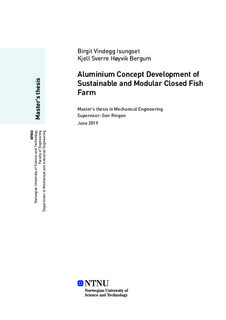| dc.contributor.advisor | Ringen, Geir | |
| dc.contributor.author | Bergum, Kjell Sverre Høyvik | |
| dc.contributor.author | Isungset, Birgit Vindegg | |
| dc.date.accessioned | 2019-10-18T14:05:38Z | |
| dc.date.available | 2019-10-18T14:05:38Z | |
| dc.date.issued | 2019 | |
| dc.identifier.uri | http://hdl.handle.net/11250/2623221 | |
| dc.description.abstract | Målet med denne oppgaven er å undersøke mulighetene for et modulært og skalerbart aluminiumkonsept for et lukket oppdrettsanlegg. Denne oppgaven tar sikte på å identifisere mulige løsninger gjennom kontinuerlig konseptutvikling, litteraturstudier, og samarbeid og kommunikasjon med ledende eksperter og tilknyttet industri. Dette utviklingsprosjektet ble gjennomført i samarbeid med TechnipFMC og NTNU Aluminium Product Innovation Center.
Med settbaserte produktutviklingsprinsipper og hurtig konseptutvikling fokuserer denne oppgaven på å dekke et bredt spekter av forskning for å identifisere de kritiske faktorene som påvirker løsningsrommet. Visuelle CAD modeller og kontinuerlig kommunikasjon med ledende eksperter var de viktigste verktøyene for å øke fremdriften i prosjektet, sammen med et bredt nettverk av eksterne kontakter for å validere funnene.
Litteraturstudier ble utført for å kartlegge kravene, standarder og forskrifter som er relevante for dette prosjektet. Den hydrodynamiske belastningen på lukkede oppdrettsanlegg, bruken av aluminium i oppdrett, aluminiumproduksjon, modellskaleringsteori og modulær produktutviklingsteori presenteres i denne oppgaven som grunnlag for utvikling.
I løpet av prosjektperioden ble det utviklet flere konsepter med fokus på modularitet, skalerbarhet og tilgjengelige produksjonsmetoder for aluminium. Å innskrenke løsningsrommet ved å forkaste de minst gjennomførbare ideene resulterte i et konsept basert på FSW-paneler med en ytre avstivningsstruktur inspirert av skipsbygging og offshore industri. Det resulterende konseptet er tilpasset modularitet og skalerbarhet, sammen med kjente produksjons- og monteringsmetoder for å minimere kostnadene.
Mer forskning innen hydrodynamiske lastkombinasjoner for lukkede oppdrettsanlegg er nødvendig for videreutvikling av konseptene. Med lasttilfellet tilgjengelig kan konstruksjonsdimensjonene bestemmes og brukes til å estimere prosjektkostnadene. Hvorvidt aluminium er et konkurransedyktig materiale sammenlignet med for eksempel betong og glassfiberarmert plast for den lukkede oppdrettsindustrien, kan da bli validert. | |
| dc.description.abstract | The goal of this thesis is to explore the possibilities of a modular and scalable aluminium concept for a closed aquaculture system. The thesis aims to identify possible solutions through continuous concept development, literature studies, and cooperation and communication with leading experts and associated industry. This development project was conducted in cooperation with TechnipFMC and NTNU Aluminium Product Innovation Centre.
With set-based product development principles and rapid concept development, this thesis focuses on covering a wide range of research to identify the critical factors affecting the solution space. Visual CAD models of the different solutions and continuous communication with leading experts were key tools to ensure the progress of this project. The findings were validated by collaborating with a wide network of external contacts.
Literature studies were conducted to map the requirements, standards and regulations relevant to this project. The hydrodynamic loads of closed aquaculture systems, the utilization of aluminium in aquaculture applications, aluminium manufacturing, model scaling theory and modular product development theory are also presented in this thesis as the foundation of development.
During the project period, several concepts with a focus on modularity, scalability and the available manufacturing methods for aluminium were generated. Narrowing down the solution space by rejecting the least feasible ideas resulted in a concept based on friction stir welded panels with an external stiffening structure inspired by the shipbuilding and offshore industry. The resulting concept accommodates modularity and scalability, together with well-known manufacturing and assembly methods to minimize costs.
More research on the topic of hydrodynamic load combinations for closed aquaculture systems is required for further development on the thesis results. With the load scenario at hand, the structure dimensions can be determined and used to estimate the project costs. Whether or not aluminium is a competitive material to for example concrete and glass fiber-reinforced plastic for the closed fish farming industry can then be validated. | |
| dc.language | eng | |
| dc.publisher | NTNU | |
| dc.title | Aluminium Concept Development of Sustainable and Modular Closed Fish Farm | |
| dc.type | Master thesis | |
